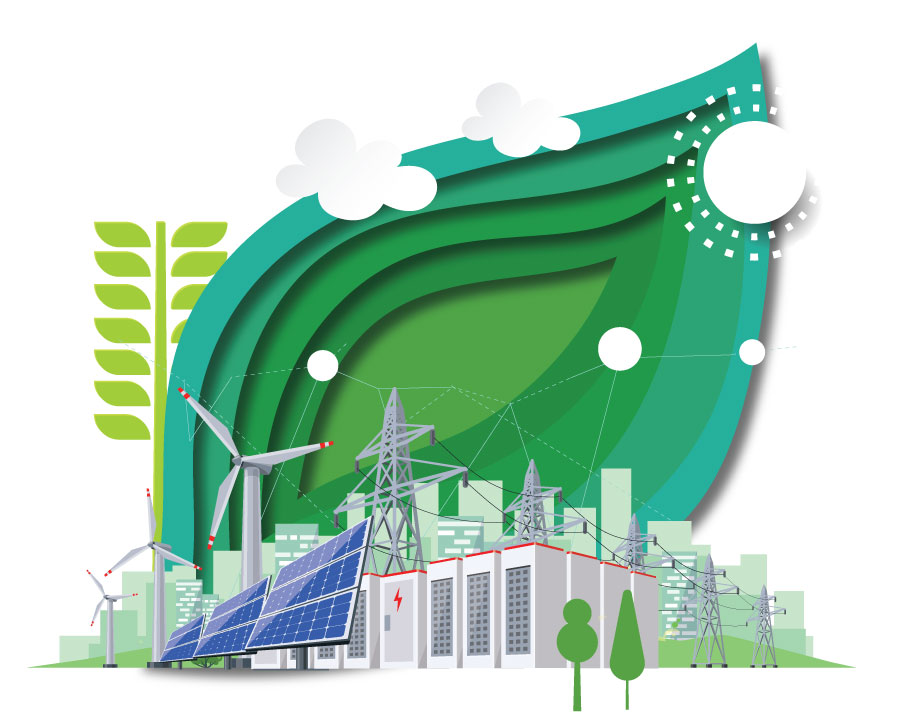Energy Blog: Nuclear Energy’s Role in Climate Change Is Quantified
Energy Blog: Nuclear Energy’s Role in Climate Change Is Quantified


A federal researcher crunched the numbers to show the value of nuclear energy in fighting climate change.
Climate change goals have countries around the world scrambling to reduce or eliminate enough carbon emissions to meet the United Nations goal of reducing greenhouse gas emissions by 43 percent by 2030 and reaching net zero by 2050. Fossil fuels, of course, are the main source and electric generating stations fueled by coal, oil, and natural gas are on the chopping block and are being replaced by renewable sources, primarily wind, solar, and batteries. But can those goals be met with just those options?
Nuclear energy is beginning to get some love and building an argument to help attain net zero, despite lingering sentiment against the power source. Germany, for instance, closed the last of its nuclear generating stations in April, although France remains steadfast with 70 percent of its electricity generated by nukes.
A new report from Pacific Northwest National Laboratory (PNNL) and the Joint Global Change Research Institute, a partnership between the University of Maryland and PNNL, quantifies the economic value of extending operations of the U.S. nuclear fleet to 2100. It also describes the contributions nuclear energy makes in limiting global warming.
Become a Member: How to Join ASME
“Lifetime extensions of the existing nuclear fleet, in the United States and globally, support urgent near-term reduction goals,” wrote Son H. Kim, a PNNL earth scientist in the paper “The Carbon Value of Nuclear Power Plant Extensions in the United States,” published in the journal Nuclear Technology. “Additionally, the longevity of nuclear power technologies reduces the need for new capacity additional of all carbon-free electricity sources and supports long-term actions necessary to maintain net-zero emissions.”
Nuclear power currently provides some 20 percent of the nation’s electricity, but many of those plants are aging and nearing the end of their operating licenses. Those scheduled to close by 2050, however, could be among the most important pieces in putting together the net-zero puzzle, especially in meeting short-term goals.
There are 93 operating reactors across 28 states, most of them built between 1970 and 1990, meaning half of them are older than their original 40-year operating license. The looming retirement of so many reactors in a short period time could have a stronger effect than staggered closings in other countries.
“Our existing nuclear power plants are aging and with their current 60-year timeframes, nearly all will be gone by 2050,” said Kim, who holds a Ph.D in nuclear engineering, in a statement. “We have a net zero goal to reach by 2050, yet our single largest source of carbon-free electricity is at risk of closure.”
More for You: Investing in America's Nuclear Future
Without adding any new capacity, Kim calculated that 60-year to 80-year extensions for existing nuclear reactors contribute to an approximate reduction of 0.4 gigatons of carbon emissions per year by 2050. Taking it one step further, the total cumulative difference in carbon-dioxide emissions between 2020 ad 2100 with lifetime extensions of existing plants and the inauguration of new nuclear plants could reach 57 gigatons of carbon emissions per year.
That is a large number. The International Energy Agency reported U.S. carbon emissions in 2022 were 4.7 gigatons. Kim says that means nuclear energy could save about 12 years of carbon emissions.
Kim’s work was done using computational models probing relationships between economic processes, energy demand, and climate. Specifically, he used the Global Change Analysis Model developed at PNNL to model scenarios that put a value on license extensions from 40 to 100 years at $330 billion to $500 billion in mitigation cost savings. That conclusion is from working under a scenario limiting global temperatures to 2˚ C. Legacy reactors have a carbon value of $500 billion if operated for 100 years.
Carbon value is the amount of dollars saved in reducing greenhouse gas emissions. According to Kim, every gigawatt of nuclear energy translates to $5 billion later saved.
Editor's Pick: Crisis Gives Unintentiional Push to Green Energy
The era of building large, site-specific nuclear power plants is over, largely because of soaring construction costs and permitting delays. But advanced reactors seem ready to replace them. Small modular reactors and microreactors are now being developed with different technologies, smaller footprints, and reduced construction time.
“SMRs and microreactors will be factory fabricated and delivered to site on trucks, and the uncertainty associated with financing costs should be reduced or eliminated,” Kim said.
NuScale Power won design approval from the Nuclear Regulatory Commission in January, and is in discussions to build one reactor in Romania. Westinghouse recently announced its AP 300 reactor, which would generate 300 MW of power. It is expected to be available by 2027.
John Kosowatz is senior editor.
Nuclear energy is beginning to get some love and building an argument to help attain net zero, despite lingering sentiment against the power source. Germany, for instance, closed the last of its nuclear generating stations in April, although France remains steadfast with 70 percent of its electricity generated by nukes.
A new report from Pacific Northwest National Laboratory (PNNL) and the Joint Global Change Research Institute, a partnership between the University of Maryland and PNNL, quantifies the economic value of extending operations of the U.S. nuclear fleet to 2100. It also describes the contributions nuclear energy makes in limiting global warming.
Become a Member: How to Join ASME
“Lifetime extensions of the existing nuclear fleet, in the United States and globally, support urgent near-term reduction goals,” wrote Son H. Kim, a PNNL earth scientist in the paper “The Carbon Value of Nuclear Power Plant Extensions in the United States,” published in the journal Nuclear Technology. “Additionally, the longevity of nuclear power technologies reduces the need for new capacity additional of all carbon-free electricity sources and supports long-term actions necessary to maintain net-zero emissions.”
Nuclear power currently provides some 20 percent of the nation’s electricity, but many of those plants are aging and nearing the end of their operating licenses. Those scheduled to close by 2050, however, could be among the most important pieces in putting together the net-zero puzzle, especially in meeting short-term goals.
There are 93 operating reactors across 28 states, most of them built between 1970 and 1990, meaning half of them are older than their original 40-year operating license. The looming retirement of so many reactors in a short period time could have a stronger effect than staggered closings in other countries.
“Our existing nuclear power plants are aging and with their current 60-year timeframes, nearly all will be gone by 2050,” said Kim, who holds a Ph.D in nuclear engineering, in a statement. “We have a net zero goal to reach by 2050, yet our single largest source of carbon-free electricity is at risk of closure.”
More for You: Investing in America's Nuclear Future
Without adding any new capacity, Kim calculated that 60-year to 80-year extensions for existing nuclear reactors contribute to an approximate reduction of 0.4 gigatons of carbon emissions per year by 2050. Taking it one step further, the total cumulative difference in carbon-dioxide emissions between 2020 ad 2100 with lifetime extensions of existing plants and the inauguration of new nuclear plants could reach 57 gigatons of carbon emissions per year.
That is a large number. The International Energy Agency reported U.S. carbon emissions in 2022 were 4.7 gigatons. Kim says that means nuclear energy could save about 12 years of carbon emissions.
Kim’s work was done using computational models probing relationships between economic processes, energy demand, and climate. Specifically, he used the Global Change Analysis Model developed at PNNL to model scenarios that put a value on license extensions from 40 to 100 years at $330 billion to $500 billion in mitigation cost savings. That conclusion is from working under a scenario limiting global temperatures to 2˚ C. Legacy reactors have a carbon value of $500 billion if operated for 100 years.
Carbon value is the amount of dollars saved in reducing greenhouse gas emissions. According to Kim, every gigawatt of nuclear energy translates to $5 billion later saved.
Editor's Pick: Crisis Gives Unintentiional Push to Green Energy
The era of building large, site-specific nuclear power plants is over, largely because of soaring construction costs and permitting delays. But advanced reactors seem ready to replace them. Small modular reactors and microreactors are now being developed with different technologies, smaller footprints, and reduced construction time.
“SMRs and microreactors will be factory fabricated and delivered to site on trucks, and the uncertainty associated with financing costs should be reduced or eliminated,” Kim said.
NuScale Power won design approval from the Nuclear Regulatory Commission in January, and is in discussions to build one reactor in Romania. Westinghouse recently announced its AP 300 reactor, which would generate 300 MW of power. It is expected to be available by 2027.
John Kosowatz is senior editor.



